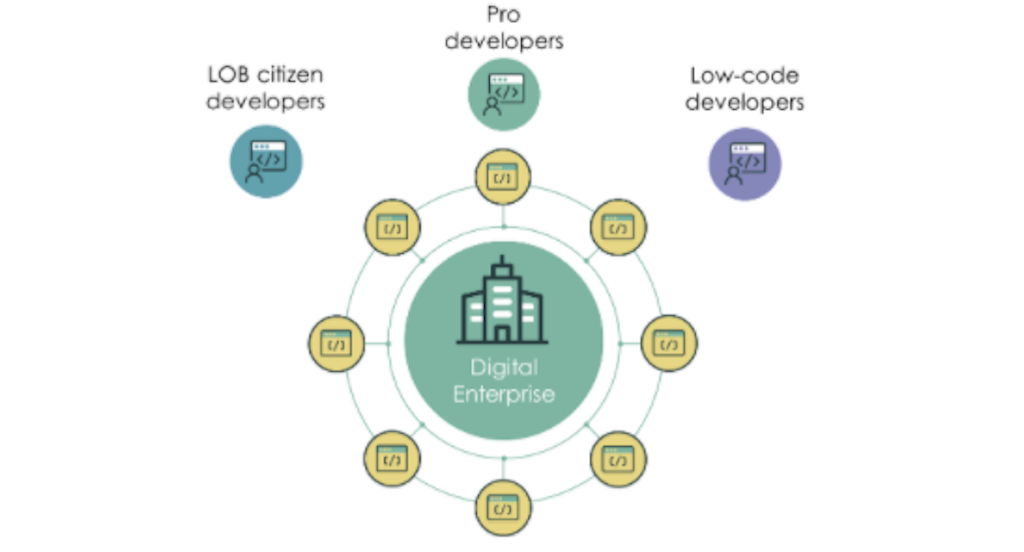The COVID-19 pandemic forced us into new ways of working that demanded a truly digital enterprise. Digital enterprises require we deliver applications for our everyday tasks and processes with unprecedented speed. Our traditional development resources – our professional developers – and traditional, professional code development environments simply cannot meet the demands from our lines of business.

The rapid adoption of low-code application platforms and the ability to use more readily available “low-code developers” partially closes the demand-supply gap by improving app delivery velocity for IT organizations. But velocity is only half the battle. Because our app development teams (pro and/or low code) can be so focused on the application itself, they may not fully understand the larger context around that application, the business processes they are attempting to digitize or how to connect with the process owners to gain that understanding. We become faster at app delivery, but not necessarily more agile. True business agility comes when we push app development to the edge; out into our lines of business and into the hands of “citizen developers.”

Now let’s all take a deep breath, pause for a moment, and accept that citizen development is not the panacea for all our digitization needs – nor is it the beginning of application anarchy. A well-executed citizen development program can dramatically improve delivery velocity and business agility if organizations make good decisions in three key areas: 1) selecting the right use cases for citizen development; 2) enabling and empowering our citizen developers; and, 3) establishing citizen development guardrails that protect our organization.
Before exploring the key decisions, it is important to note a few elements that are consistent across successful citizen development programs:
- Adopting a Low-Code Application Platform (LCAP) – LCAPs benefit IT developers (both professional and low-code) but are critical to citizen developers. Teaching Java to your lines of business is what’s called a distributed development model – and that’s a whole different article.
- Embracing the Journey – A citizen development program is a learning process for both the IT organization and the lines of business. Start focused, learn from the experience, adjust the approach and expand the reach.
- Marketing Success – It is important to raise awareness of the program by telling the company about both the successes and the lessons learned – be candid and clear. People feel good about successful programs and rally around them.
Selecting the Right Use Cases for Citizen Development
We want to set up citizen developers, and the citizen developer program, for success, which means matching the business need to the citizen developer skillset.
We need answer the following questions regarding line of business needs.
- What business use cases are a good fit for our LCAP?
- What technical requirements are a good fit for our LCAP? What technical requirements are not?
- What types of applications in our enterprise are a good fit for citizen development?
- Are there lines of business / departments that could benefit more than others from empowering citizen developers?
- Are there specific risk, compliance, security and legal (RSCL) mandates that need to be addressed?
- Are there other core enterprise systems that need to be considered for certain use cases?
- Are there legacy technologies and/or is there technical debt that should be targeted?
- What is the potential return on investment? How quickly can we start achieving that ROI?
The answers to these questions are not binary. These questions, and others unique to each company, provide a filter to vet – and possibly score – use cases to determine suitability for a citizen development program.
Just as important as selecting the right use cases is finding the right citizen developers. We need to answer the following questions about any potential citizen developers.
- Will we have different categories of distributed / citizen developers? Are those categories based on skill level, organization and/or access?
- Have we identified the aptitude and attitude characteristics of a good citizen developer?
- How will we recruit and incentivize developers to join the program?
- What is our value proposition to the citizen developer’s manager? Why would they support allocating some portion of their resource(s) building apps?
In the early stages of a citizen development program, the most successful programs tend to prioritize the right developer over the right use case. A “high fit” developer delivering a “medium value” use case is a better bet than a “low fit” developer attempting a “high value” use case. Early wins matter.
In part two of this series, we will explore enabling and empowering our citizen developers. We have now identified the right use cases and the right citizen developers, so let’s set them up for success.
This post is the first of a three-part series offering real-world insights on delivering business value from citizen development initiatives.



